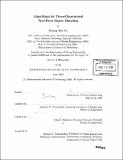Algorithms for three-dimensional free-form object matching
Author(s)
Ko, Kwang Hee, 1971-
DownloadFull printable version (9.495Mb)
Alternative title
Algorithms for 3D free-form object matching
Other Contributors
Massachusetts Institute of Technology. Dept. of Ocean Engineering.
Advisor
Nicholas M. Patrikalakis and Takashi Maekawa.
Terms of use
Metadata
Show full item recordAbstract
This thesis addresses problems of free-form object matching for the point vs. NURBS surface and the NURBS surface vs. NURBS surface cases, and its application to copyright protection. Two new methods are developed to solve a global and partial matching problem with no a priori information on correspondence or initial transformation and no scaling effects, namely the KH and the umbilic method. The KH method establishes a correspondence between two objects by utilizing the Gaussian and mean curvatures. The umbilic method uses the qualitative properties of umbilical points to find correspondence information between two objects. These two methods are extended to deal with uniform scaling effects. The umbilic method is enhanced with an algorithm for scaling factor estimation using the quantitative properties of umbilical points. The KH method is used as a building block of an optimization scheme based on the golden section search which recovers iteratively an optimum scaling factor. Since the golden section search only requires an initial interval for the scaling factor, the solution process is simplified compared to iterative optimization algorithms, which require good initial estimates of the scaling factor and the rigid body transformation. The matching algorithms are applied to problems of copyright protection. (cont.) A suspect model is aligned to an original model through matching methods so that similarity between two geometric models can be assessed to determine if the suspect model contains part(s) of the original model. Three types of tests, the weak, intermediate and strong tests, are proposed for similarity assessment between two objects. The weak and intermediate tests are performed at node points obtained through shape intrinsic wireframing. The strong test relies on isolated umbilical points which can be used as fingerprints of an object for supporting an ownership claim to the original model. The three tests are organized in two decision algorithms so that they produce systematic and statistical measures for a similarity decision between two objects in a hierarchical manner. Based on the systematic statistical evaluation of similarity, a decision can be reached whether the suspect model is a copy of the original model.
Description
Thesis (Ph. D.)--Massachusetts Institute of Technology, Dept. of Ocean Engineering, 2003. Includes bibliographical references (leaves 117-126).
Date issued
2003Department
Massachusetts Institute of Technology. Department of Ocean EngineeringPublisher
Massachusetts Institute of Technology
Keywords
Ocean Engineering.